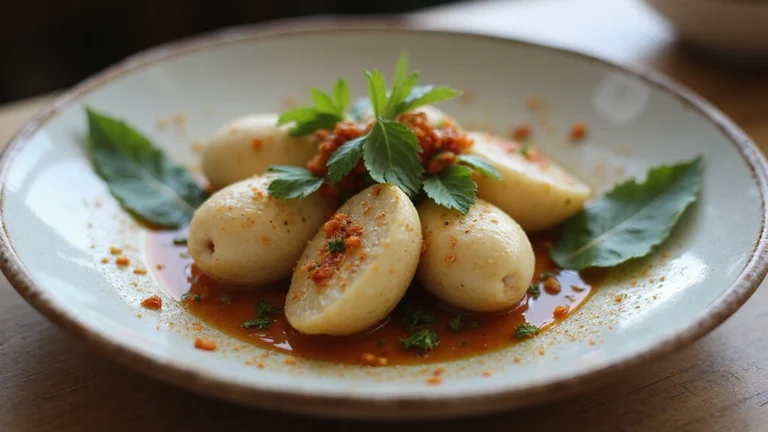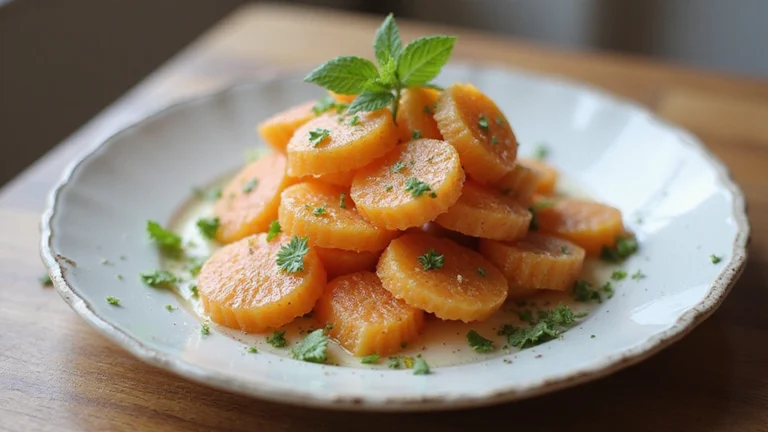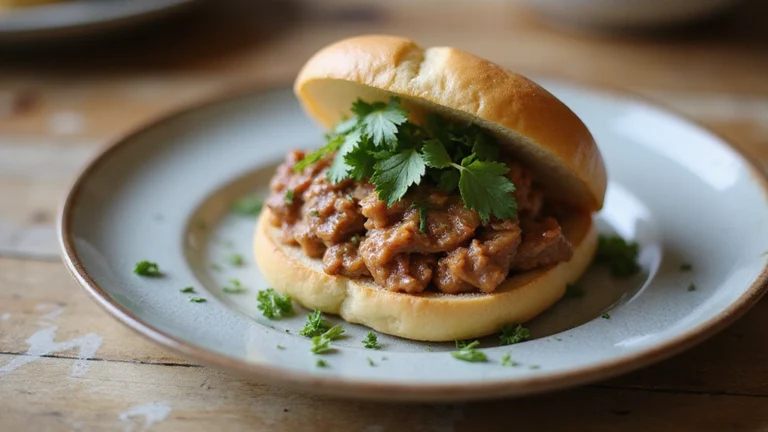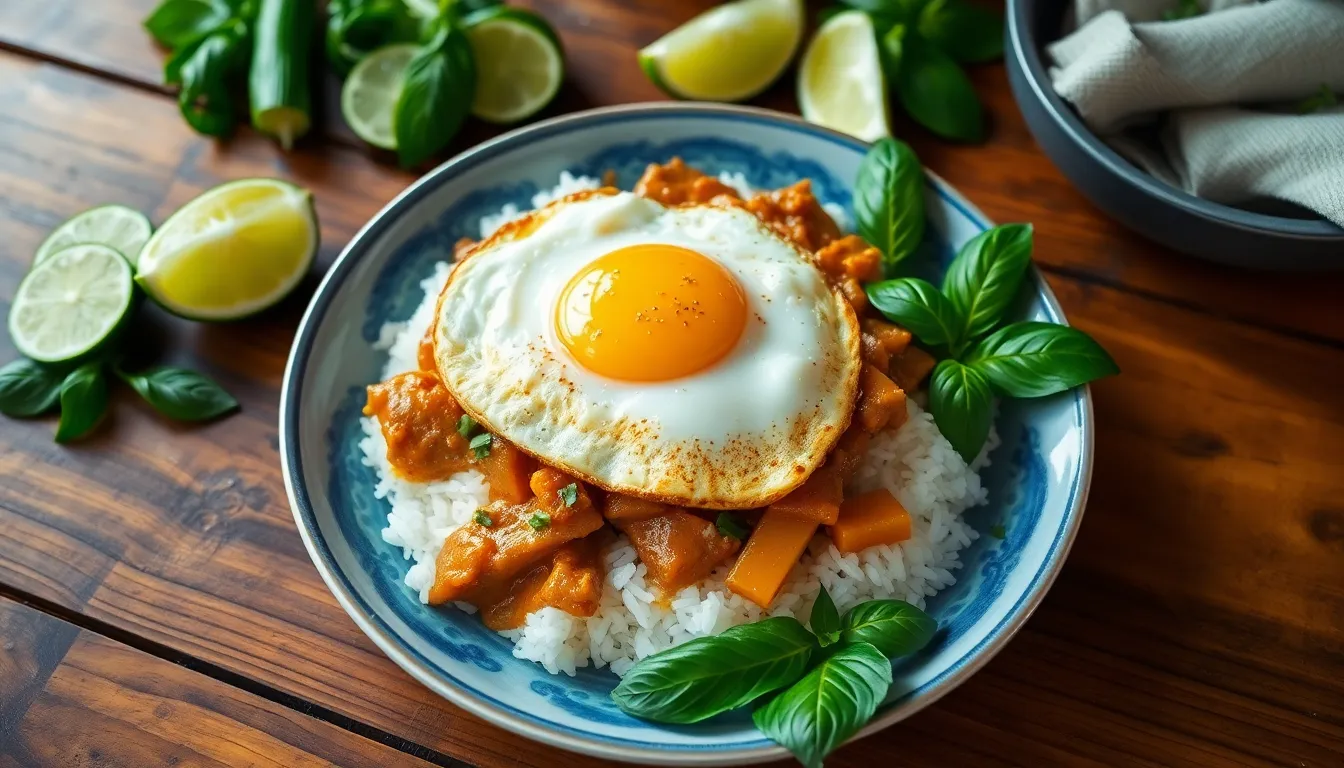
Ever wondered how to make authentic Thai basil pork at home in just 15 minutes? This classic Thai street food recipe, known locally as Pad Gkaprow Mu, is a staple in Thailand that appears on tables from breakfast through dinner.
This slightly spicy dish combines ground pork with aromatic garlic, shallots, Thai chilis, and fresh basil leaves, all brought together with a savory sauce of fish sauce, soy sauce, and oyster sauce. The result is a perfect balance of salty, sweet, and spicy flavors that’s both cheaper and more satisfying than takeout. Topped with a crispy fried egg with a runny yolk that cuts through the spiciness, this restaurant-quality meal delivers maximum flavor with minimal effort.
What Is Thai Basil Ground Pork?
Thai Basil Ground Pork, known in Thailand as Pad Kra Pao, is one of Thailand’s most beloved street food dishes that combines aromatic herbs with savory meat. This spicy stir-fry features ground pork cooked with garlic, shallots, and Thai chili peppers in a flavorful sauce of fish sauce, light soy sauce, and oyster sauce with a touch of sugar for balance.
The star ingredient that gives this dish its distinctive flavor and name is Thai holy basil (kra pao), which has a bold peppery taste with hints of clove. This basil variety differs significantly from Thai sweet basil (horapa), which has licorice and anise notes, or Italian basil, which is sweeter and milder.
Traditional pad kra pao is typically served over jasmine rice with a crispy fried egg on top. The runny yolk creates a rich sauce that perfectly complements the spicy meat mixture. The dish offers a complex flavor profile that’s simultaneously spicy, savory, and slightly sweet, with the aromatic holy basil providing a unique peppery finish.
While ground pork is the most common protein choice along with chicken, you can also make this versatile dish with ground beef, shrimp, or tofu for different variations. The entire meal comes together in just 20 minutes in a single pan, making it an ideal weeknight dinner option that delivers authentic Thai flavors without requiring hours in the kitchen.
Ingredients
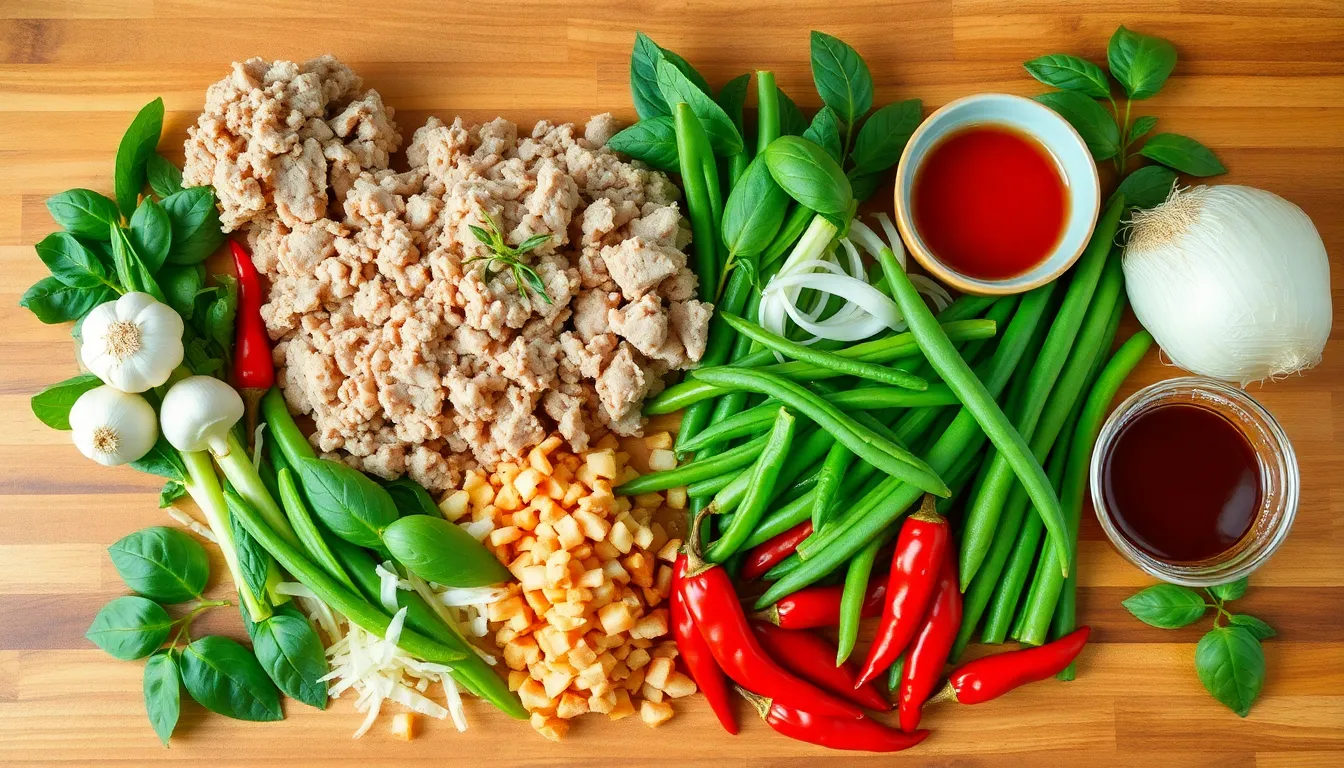
Creating authentic Thai ground pork stir-fry requires a careful balance of aromatic ingredients and savory sauces. The following ingredients will help you achieve that perfect combination of sweet, salty, and spicy flavors that make Thai cuisine so distinctive.
For The Stir-Fry Sauce
- 1 tablespoon light soy sauce
- 2 teaspoons dark soy sauce (adds color and depth)
- 1 tablespoon oyster sauce
- 1 tablespoon fish sauce
- 1½ teaspoons granulated sugar (or 1 teaspoon brown sugar)
- ¼ cup chicken broth or water (optional, for adjusting sauce consistency)
For The Main Dish
- 1 pound (450g) ground pork
- 5 cloves garlic, minced
- 1 shallot, minced (or half a small onion, thinly sliced)
- 3-6 Thai bird’s eye chilies, thinly sliced (adjust according to heat preference)
- 1 cup Thai holy basil leaves, packed (Thai basil can substitute if holy basil is unavailable)
- 1 tablespoon vegetable oil for stir-frying
- Optional vegetables: green beans, cabbage, or yellow string beans (1-2 cups, chopped)
- 4 eggs for frying (1 per serving)
- Steamed jasmine rice for serving
Tools And Equipment Needed

Preparing authentic Thai ground pork dishes requires exact equipment to achieve those bold, aromatic flavors. With the right tools, you’ll be able to replicate the street food experience right in your kitchen.
Essential Equipment
A wok stands as the centerpiece for Thai cooking. Carbon steel woks with flat bottoms provide excellent heat distribution, critical for the high-heat cooking style that defines Thai cuisine. If you don’t have access to a traditional wok, a well-seasoned large non-stick pan works as an acceptable alternative for home cooking.
Granite mortar and pestle plays a crucial role in Thai cooking for pounding spices and making curry pastes. Your mortar should measure at least 6 inches wide and deep for effective pounding. Avoid marble mortars as they tend to be too fragile for the vigorous pounding required for Thai spice pastes.
A quality cutting board and sharp knife are indispensable for preparing aromatics like garlic, shallots, and chilies that form the flavor base of dishes like Pad Kra Pao Moo Saap. Many Thai cooks prefer a cleaver for chopping meat to achieve the desired texture.
Measuring spoons ensure accuracy when adding fish sauce, soy sauce, and oyster sauce to create the perfect balance of flavors in your Thai ground pork dishes.
Additional Helpful Items
A rice cooker simplifies the preparation of jasmine rice, the traditional accompaniment to Thai ground pork dishes. Perfect rice creates the ideal base for soaking up the flavorful sauces.
A small bowl for mixing sauce ingredients helps you combine fish sauce, soy sauce, oyster sauce, and sugar before adding them to the wok.
Cooking chopsticks or a spatula with a long handle protects your hands from the high heat while allowing you to stir-fry efficiently.
A non-stick pan dedicated to frying eggs comes in handy when preparing the crispy fried egg that traditionally tops dishes like Pad Kra Pao. The runny yolk adds richness that balances the spicy flavors of the dish.
With these tools at your disposal, you’ll be well-equipped to create authentic Thai ground pork dishes like Pad Kra Pao Moo Saap (Thai Basil Minced Pork) and Laab Moo Isan (Isan-style Minced Pork Salad) that capture the genuine flavors of Thai street food.
Preparation Tips
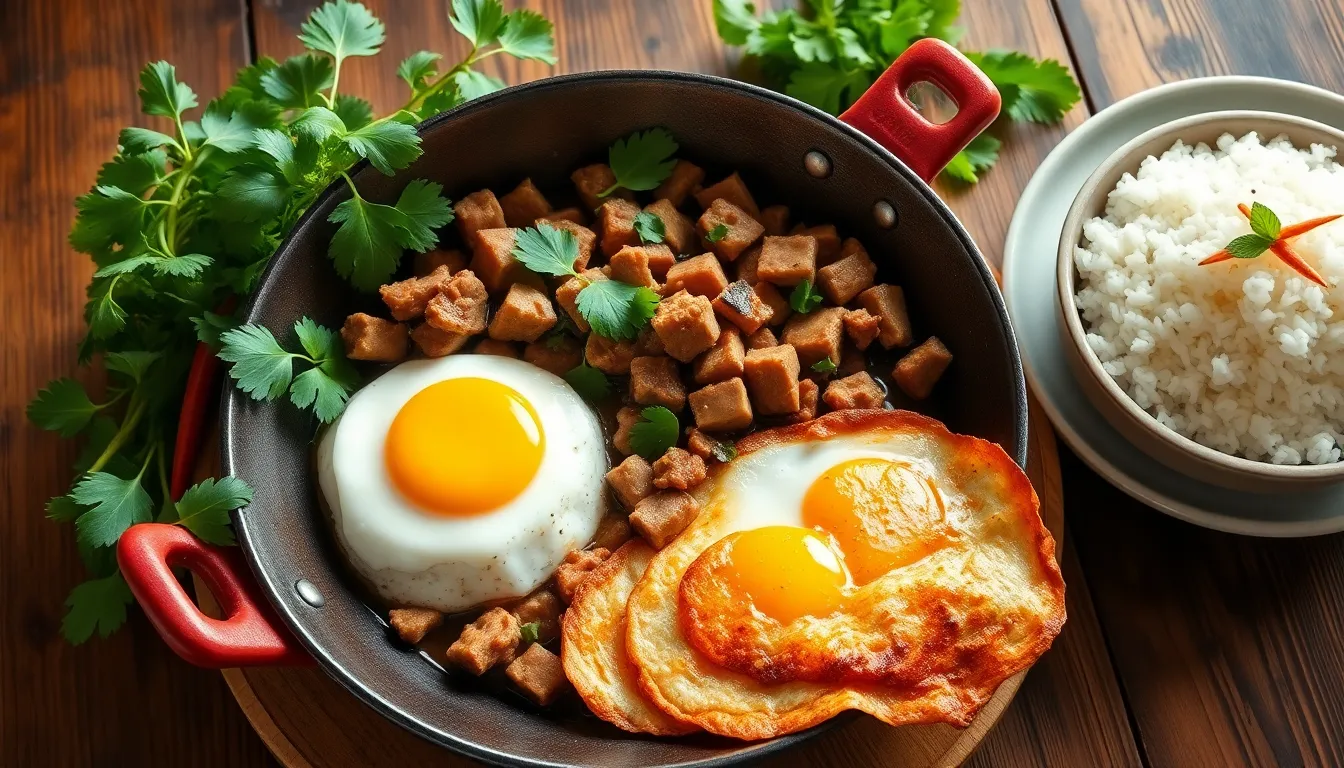
Marinating the Ground Pork
Start your Thai ground pork dish with proper marination to develop deep flavors. The traditional Thai “saam gler” (สามเกลอ) or “three friends” base creates an authentic foundation for your dish. Pound cilantro roots white peppercorns and garlic together until finely combined. Mix this aromatic paste with soy sauce and a touch of sugar then thoroughly incorporate it into your ground pork. Allow the meat to absorb these flavors for at least 10 minutes before cooking. This simple marinade balances savory aromatic and slightly sweet notes improving the pork’s natural taste whether you’re making stir-fries dumplings or Thai pork balls.
Cooking Method for Perfect Results
Heat your wok or large skillet until it’s very hot before adding a tablespoon of neutral oil. Fry pounded chili and garlic briefly (about 30-45 seconds) until fragrant but not burned. Add your ground pork immediately afterward breaking it apart in the pan. Use high heat to give the pork a nice sear which caramelizes the meat and enhances flavor. Stir-fry quickly for 2-4 minutes until the pork changes color and cooks through completely.
For dishes like Thai basil minced pork (Pad Kra Pao) remove the cooked pork temporarily. Sauté fresh garlic and diced vegetables such as bell peppers and onions in the same pan until softened. Return the pork to the wok then add fresh Thai basil leaves. Season with your prepared sauce of fish sauce soy sauce and sugar stirring until the basil wilts about 1 minute.
Flavor Enhancement Techniques
Thai holy basil provides the signature spicy peppery aroma essential to authentic Pad Kra Pao. Add this herb at the very end of cooking to preserve its distinctive flavor and aroma. Brighten your finished dish with a squeeze of fresh lime juice which adds a pleasant acidity that balances the savory elements.
For a spicier result smash your Thai chilies and garlic in a mortar and pestle before cooking. This technique releases more of the aromatic oils within the chilies intensifying the heat. Reduce spiciness by using fewer chilies and removing their seeds which contain most of the heat.
Serve your Thai ground pork dish with a crispy fried egg featuring a runny yolk. The rich creamy yolk cuts through the spiciness of the dish and adds wonderful texture contrast to the minced pork. Place your completed dish over freshly steamed jasmine rice for an authentic Thai street food experience at home.
Cooking Instructions
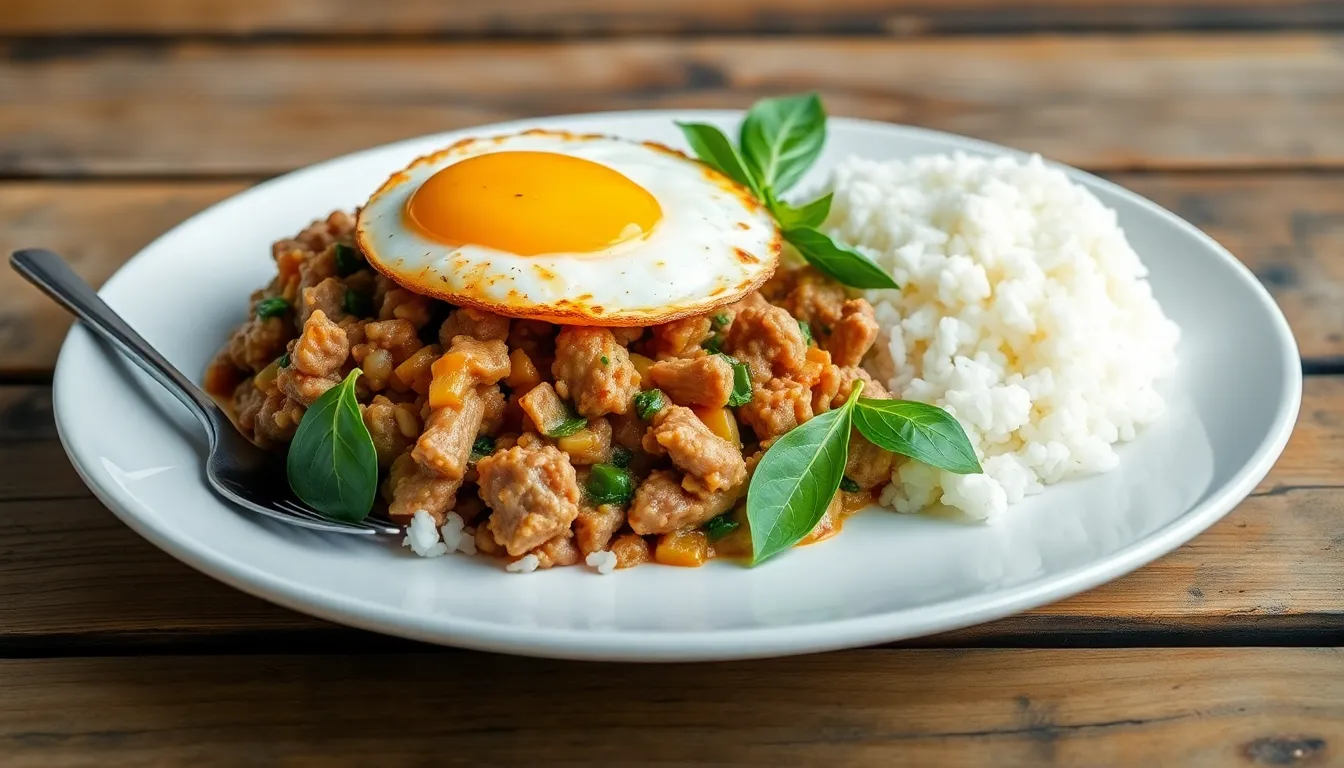
Prepare this authentic Thai basil ground pork in three simple stages for the perfect balance of flavors. This dish comes together quickly in about 20 minutes total cooking time making it ideal for weeknight meals.
Preparing The Sauce
Combine 2 tablespoons oyster sauce, 2 tablespoons light soy sauce, 1/2 tablespoon fish sauce, and 1 1/2 tablespoons white sugar in a small mixing bowl. Add 1/2 tablespoon rosdee seasoning powder (a Thai umami seasoning) if available; substitute with golden mountain sauce or additional soy sauce if needed. Mix these ingredients thoroughly until the sugar dissolves completely. Set this sauce mixture aside while you prepare the other components.
Cooking The Ground Pork
Heat 2 tablespoons of neutral oil in a wok or large skillet over medium-high heat until shimmering. Crush 4 cloves of garlic and 4 small Thai chilies together using a mortar and pestle (or finely chop them) then add to the hot oil. Stir-fry for about 20 seconds until aromatic but not burned. Add 12 ounces (approximately 1 1/2 cups) ground pork to the pan. Break apart the pork with your spatula and continue stir-frying for 2-3 minutes until fully cooked but still juicy. Pour the prepared sauce over the cooked pork and stir to coat evenly. Add 1/4 cup chicken broth for moisture and simmer for another 1-2 minutes to allow the flavors to meld together.
Final Assembly
Turn off the heat and immediately add a handful of fresh Thai holy basil leaves to the hot pork mixture. Stir quickly until the basil wilts but remains vibrant green, about 30-60 seconds. Transfer the pad kra pao to serving plates with steamed jasmine rice on the side. Top each portion with a crispy fried egg (kai dao) for the traditional presentation. The runny yolk creates a rich sauce that perfectly complements the spicy pork when broken and mixed with the meat. Serve immediately while hot for the most authentic flavor experience.
Serving Suggestions
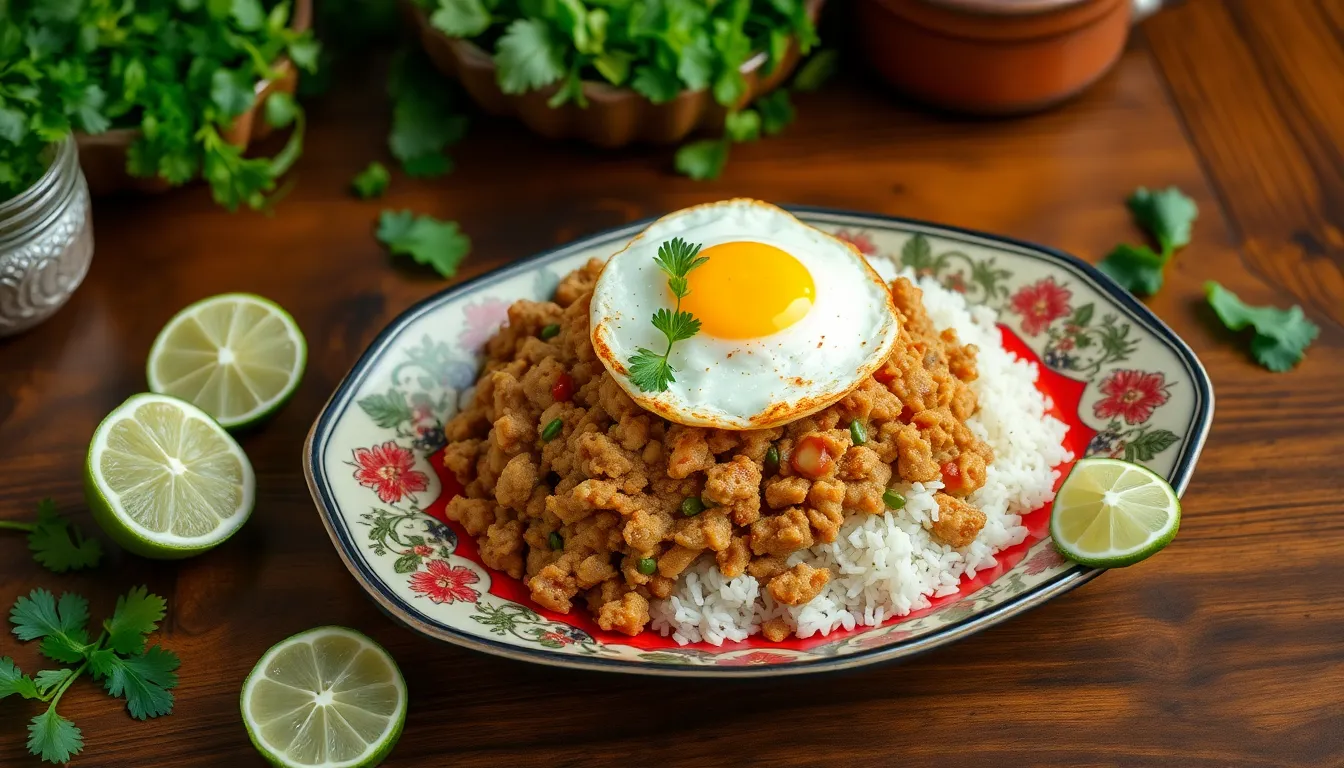
Thai ground pork dishes deserve proper presentation to enhance their authentic flavors and create a complete dining experience. Traditional Thai serving styles not only look impressive but also balance the dish’s bold flavors perfectly.
Jasmine Rice Foundation
Serve your Thai ground pork over a bed of fragrant jasmine rice. The subtle aroma and slightly sticky texture of jasmine rice provides the perfect canvas for soaking up the savory sauce from dishes like Pad Kra Pao. Coconut rice offers an excellent alternative that adds a subtle sweetness to balance the spicy pork.
Fried Egg Enhancement
Top your Thai ground pork with a crispy-edged fried egg with a runny yolk. This classic addition to Pad Kra Pao (Thai Basil Pork) transforms the dish by creating a rich sauce when the yolk breaks and mixes with the spicy meat. Thai street vendors and restaurants consistently pair this protein-packed dish with an egg for good reason – it’s delicious.
Fresh Accompaniments
Arrange fresh vegetables alongside your Thai ground pork dish:
- Cucumber slices provide cooling crunch
- Lettuce leaves for wrapping (especially with Laab Moo Isan)
- Fresh lime wedges for squeezing over the dish
- Sprigs of cilantro, mint, and additional basil as garnish
Condiment Additions
Place small dishes of Thai condiments on the table to allow customization:
- Prik Nam Pla (fish sauce with Thai chilies)
- Sliced fresh chilies in vinegar
- Dried chili flakes
- Nam Prik Pao (Thai chili paste)
Traditional Pairing Options
Complete your Thai meal with traditional side dishes. A small bowl of clear broth soup often accompanies ground pork dishes in Thailand, cleansing the palate between bites. Pickled vegetables add a tangy contrast to the rich pork flavors, while a simple papaya salad (Som Tam) provides refreshing crunch alongside heartier Laab Moo Isan.
Presentation Tips
Serve Thai ground pork dishes family-style on a central platter with individual bowls of rice. For Pad Kra Pao, plate individual portions with rice on one side and the pork mixture on the other, topped with a fried egg. Present Laab Moo in a decorative bowl surrounded by fresh herbs and vegetables for wrapping, encouraging interactive dining.
Storage And Make-Ahead Tips
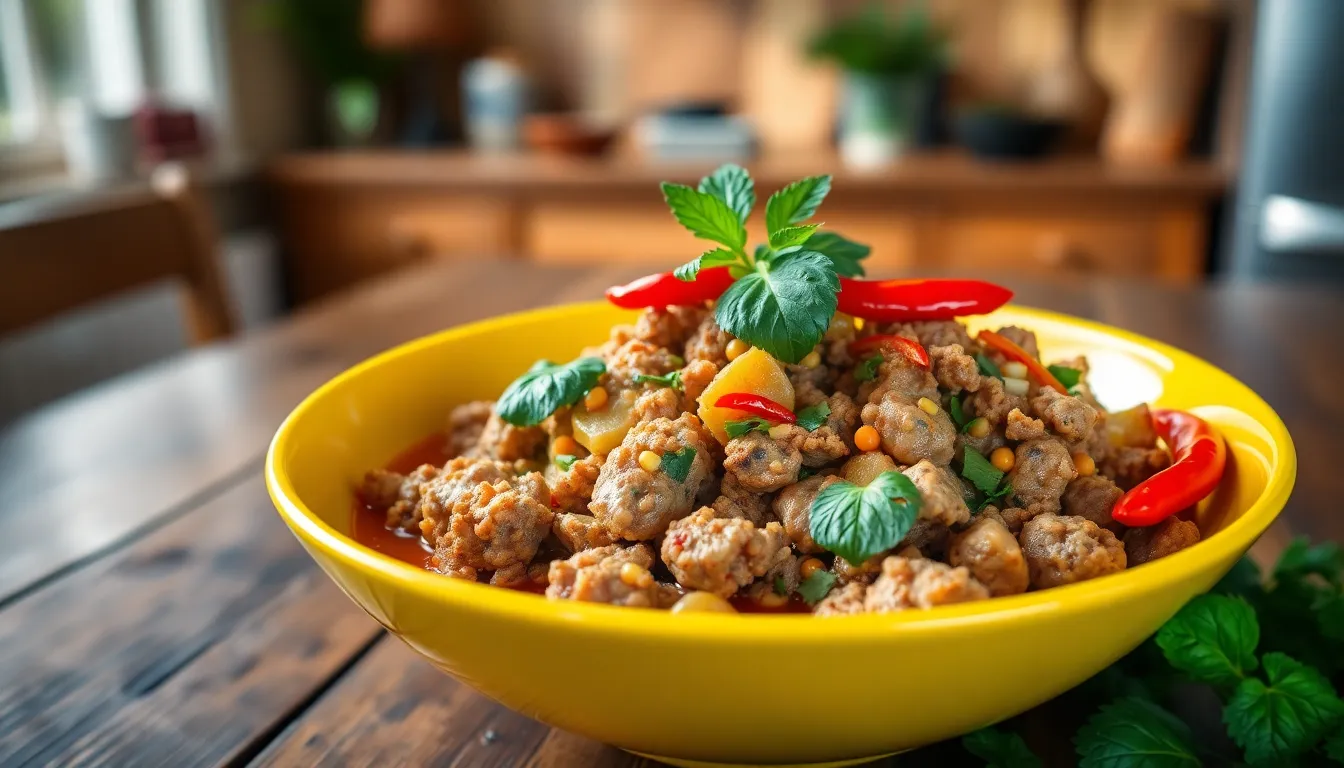
Proper storage of Thai basil ground pork ensures you can enjoy this delicious dish beyond just one meal. Follow these guidelines to maintain flavor and food safety when storing or preparing this dish ahead of time.
Refrigeration
Store your cooked Thai basil ground pork in an airtight container in the refrigerator for up to 3-4 days. Raw ground pork should never be kept longer than 1-2 days in the refrigerator before cooking to ensure food safety. When storing dishes like Pad Kra Pao that include vegetables, keep them together with the cooked meat for convenience.
For Thai salads like Larb Moo that incorporate fresh vegetables, store the cooked pork mixture separately from crisp components like lettuce and cucumbers. This separation helps maintain the ideal texture of each ingredient until serving time.
Freezing Options
Freeze cooked Thai ground pork dishes for longer preservation, where they’ll maintain quality for 2-3 months. Raw ground pork freezes well for 3-4 months when properly wrapped. Portion your Thai basil pork into meal-sized containers before freezing for easier reheating later.
Label containers with the date to track freshness and ensure you use them within the recommended timeframe. Thaw frozen cooked dishes overnight in the refrigerator for best results before reheating.
Reheating Guidelines
Reheat refrigerated Thai basil ground pork in a skillet over medium heat with a splash of water to restore moisture. The water prevents the dish from drying out while warming. Stir occasionally until the dish reaches an internal temperature of 165°F.
Microwave reheating works well for quick meals – cover the container to trap steam and heat thoroughly. For frozen portions, thaw completely before reheating to ensure even warming throughout the dish.
Make-Ahead Tips
Prepare Thai ground pork dishes like Pad Kra Pao completely up to 3 days ahead for convenient weeknight meals. The flavors often intensify after a day in the refrigerator as the aromatics further infuse the meat.
For entertaining, cook the pork mixture in advance but add the fresh Thai basil just before serving to maintain its vibrant color and aroma. When making ahead, consider slightly undercooking the dish initially, as reheating will continue the cooking process.
Food Safety Practices
Always maintain temperature control by keeping raw pork below 40°F during storage. Separate uncooked pork from ready-to-eat foods to prevent cross-contamination. Heat leftovers thoroughly to 165°F to kill any potential bacteria.
Transport cooked Thai pork dishes in insulated containers if you’re taking them to work or gatherings. Never leave cooked ground pork at room temperature for more than 2 hours to avoid bacterial growth.
Recipe Variations
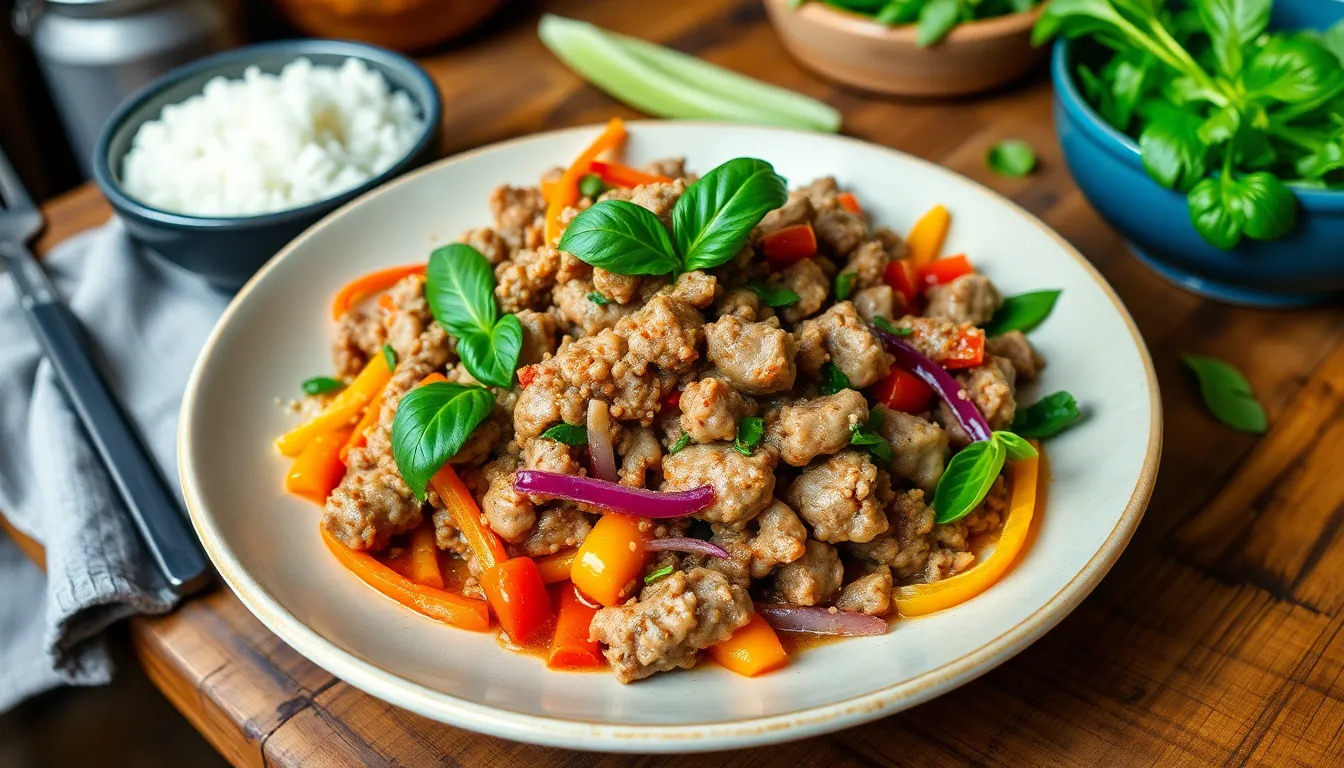
Thai basil ground pork offers endless possibilities for customization while maintaining its authentic flavors. These variations allow you to adapt the classic Pad Kra Pao to suit your preferences and available ingredients.
Different Protein Options
Ground pork creates the traditional version of Pad Kra Pao but several other proteins work beautifully in this dish. Ground chicken provides a lighter alternative with a milder flavor profile while still absorbing the savory sauce components. Ground turkey offers another lean option that works well with the bold aromatics and spices. Ground beef delivers a richer taste that pairs wonderfully with the holy basil and creates a more robust version known as Thai Basil Beef.
For seafood lovers shrimp can replace ground meat entirely providing a sweet delicate flavor that contrasts nicely with the spicy elements. Vegetarians and vegans can enjoy this dish by substituting tofu or mushrooms for the meat. Crumbled firm tofu or finely chopped mushrooms absorb the flavorful sauce while maintaining a satisfying texture. Regardless of which protein you choose the essential flavor components from holy basil garlic chilies and the balanced sauce remain the foundation of this versatile dish.
Adjusting Spice Levels
The signature heat in Pad Kra Pao comes primarily from Thai bird’s eye chilies which can be modified to suit your spice tolerance. For a milder version remove the seeds from the chilies before slicing as they contain most of the capsaicin that creates intense heat. You can also reduce the quantity of chilies used in the recipe going from the traditional 3-5 down to just 1-2 for a gentler kick.
Those who prefer less spice can substitute Thai chilies with milder varieties like jalapeños or even sweet bell peppers for flavor without heat. Adding more sugar to the sauce helps balance spiciness by countering the heat with sweetness. For spice enthusiasts increase the number of chilies or add chili flakes or paste to intensify the heat level.
A professional technique involves smashing the chilies and garlic together in a mortar and pestle before cooking which releases more aromatic oils from the chilies and intensifies their flavor throughout the dish. This method produces a more authentic taste profile with evenly distributed heat rather than concentrated pockets of spiciness. The beauty of this dish lies in how easily you can adjust its spice level while maintaining the harmonious blend of salty sweet and umami flavors that make Thai cuisine so beloved.
Authentic Thai Flavors At Home

Achieving restaurant-quality Thai flavors in your home kitchen isn’t as challenging as you might think. Thai cuisine balances sweet, salty, spicy, and sour elements to create dishes that burst with distinctive aromatics and depth.
Understanding Key Thai Ingredients
The foundation of authentic Thai cooking lies in using the right ingredients. Fish sauce provides a savory umami base that’s essential in dishes like Pad Kra Pao. Light soy sauce adds saltiness while oyster sauce contributes richness and subtle sweetness. Thai holy basil (gaprao) delivers a peppery, slightly spicy flavor that cannot be replicated by sweet basil or Italian varieties, though these can work as substitutes in a pinch.
Bird’s eye chilies bring necessary heat to balance the savory components. The aromatics – garlic and shallots – create the fragrant base that makes Thai food instantly recognizable. Ground pork with a good fat ratio ensures juiciness and better flavor absorption when cooked.
Balancing Thai Flavor Profiles
Thai cuisine excels at creating harmony between contrasting flavors:
| Flavor Component | Common Ingredients | Role in Thai Cooking |
|---|---|---|
| Salty | Fish sauce, soy sauce | Creates depth and enhances other flavors |
| Sweet | Sugar, oyster sauce | Balances heat and acidity |
| Sour | Lime juice | Brightens dishes and cuts richness |
| Spicy | Bird’s eye chilies | Provides heat that builds complexity |
| Umami | Fish sauce, oyster sauce | Adds satisfying savory notes |
The magic happens when these elements work together. In Pad Kra Pao, the saltiness from fish sauce meets the mild sweetness of oyster sauce while chilies provide heat and holy basil adds aromatic complexity.
Techniques for Authentic Thai Cooking
Proper technique matters just as much as ingredients. When cooking ground pork for Thai dishes, moderate heat works better than high heat. The meat naturally releases moisture, so gentle stir-frying produces better results than attempting to sear it quickly.
Add holy basil at the very end of cooking to preserve its aromatic qualities. The leaves should wilt slightly but remain vibrant green. This timing ensures the essential oils release their flavor without breaking down completely.
For Larb Nam Tok, allowing the lime juice to penetrate the cooked ground pork creates the signature tangy profile. The addition of toasted sticky rice powder provides authentic texture and nutty flavor that elevates this northeastern Thai specialty.
Serve your Thai ground pork dishes with the appropriate rice – jasmine rice pairs perfectly with Pad Kra Pao while sticky rice traditionally accompanies Larb Nam Tok from the Issan region. The crispy fried egg topping on Pad Kra Pao isn’t just for presentation; when broken, the runny yolk creates a rich sauce that melds beautifully with the spicy pork mixture.
Conclusion
Thai ground pork dishes like Pad Kra Pao bring authentic street food flavors right to your kitchen with minimal effort. You’ll master this versatile meal with just a few key ingredients and basic techniques that deliver bold Thai flavors in minutes.
The secret lies in balancing salty fish sauce with sweet and savory elements while letting aromatic Thai holy basil shine. Whether you stick with traditional ground pork or experiment with other proteins the result is always satisfying.
Remember that a proper wok helps but isn’t essential and don’t skip the crispy-edged fried egg on top! With these tips you’ll create restaurant-quality Thai ground pork dishes that become weeknight favorites without breaking your budget or consuming your evening.
Frequently Asked Questions
What is Thai Basil Pork (Pad Gkaprow Mu)?
Thai Basil Pork, or Pad Gkaprow Mu, is an authentic Thai street food dish made with ground pork, garlic, shallots, Thai chilies, and fresh Thai holy basil. It features a savory sauce combining fish sauce, soy sauce, and oyster sauce, creating a perfect balance of salty, sweet, and spicy flavors. This popular dish is typically served over jasmine rice with a crispy fried egg on top.
How long does it take to make Thai Basil Pork?
Thai Basil Pork takes just 15-20 minutes to prepare from start to finish. It’s a one-pan dish that requires minimal preparation and cooking time, making it perfect for busy weeknights when you want authentic Thai flavors without spending hours in the kitchen. The quick cooking process also helps preserve the freshness of the ingredients.
What is the difference between Thai holy basil and regular basil?
Thai holy basil (Kra Pao) has a distinctive bold, peppery flavor with hints of clove that’s essential for authentic Pad Kra Pao. It’s more robust and spicier than regular sweet basil or Italian basil. The leaves are typically smaller with slightly serrated edges and purplish stems. If unavailable, Thai sweet basil is the closest substitute, though the dish will have a slightly different flavor profile.
Can I use other proteins instead of pork?
Absolutely! While ground pork is traditional, you can substitute it with ground chicken, turkey, beef, or shrimp for equally delicious results. For vegetarian options, tofu or mushrooms work well. Each protein will give the dish a slightly different flavor profile, but the essential Thai seasonings will still shine through. Just adjust cooking times accordingly as some proteins cook faster than others.
What tools do I need to make authentic Thai Basil Pork?
Ideally, use a wok for optimal heat distribution, but a large non-stick skillet works too. Other helpful tools include a mortar and pestle for smashing chilies and garlic (enhancing flavor release), a sharp knife and cutting board for prep work, measuring spoons for sauce ingredients, and a spatula for stir-frying. A rice cooker is beneficial for perfect jasmine rice.
How spicy is Thai Basil Pork?
Traditional Thai Basil Pork is quite spicy due to the Thai bird’s eye chilies used. However, you can easily adjust the heat level by controlling the number of chilies. For a mild version, use just 1-2 deseeded chilies. For medium heat, add 3-4 chilies. For authentic Thai spiciness, use 5 or more chilies with seeds intact. You can also substitute with milder pepper varieties.
What’s the best way to serve Thai Basil Pork?
Serve Thai Basil Pork over steamed jasmine rice with a crispy fried egg on top (the runny yolk creates a rich sauce when broken). Add fresh cucumber slices, lime wedges, and lettuce leaves on the side for a cooling effect. A small bowl of nam pla prik (fish sauce with chilies) can be served alongside for additional seasoning according to personal taste.
How can I store leftover Thai Basil Pork?
Store leftover Thai Basil Pork in an airtight container in the refrigerator for up to 3-4 days. For longer storage, freeze portions for 2-3 months. To reheat, microwave with a sprinkle of water to prevent drying out, or warm in a skillet over medium heat. The flavors often intensify after a day, making leftovers particularly delicious.
Is Thai Basil Pork healthy?
Thai Basil Pork can be a relatively healthy option, especially when prepared at home where you control the ingredients. It’s high in protein from the pork and contains beneficial compounds from garlic, shallots, and basil. To make it healthier, use lean ground pork, reduce oil, limit sugar in the sauce, and add extra vegetables like green beans or bell peppers.
What makes the sauce in Thai Basil Pork so flavorful?
The distinctive flavor comes from a balanced combination of key Thai ingredients: fish sauce provides umami and saltiness, soy sauce adds depth, oyster sauce contributes sweetness and richness, and a touch of sugar balances the heat. The aromatic blend of fresh garlic, shallots, and Thai chilies creates the foundation, while Thai holy basil adds its unique peppery flavor that defines the dish.
